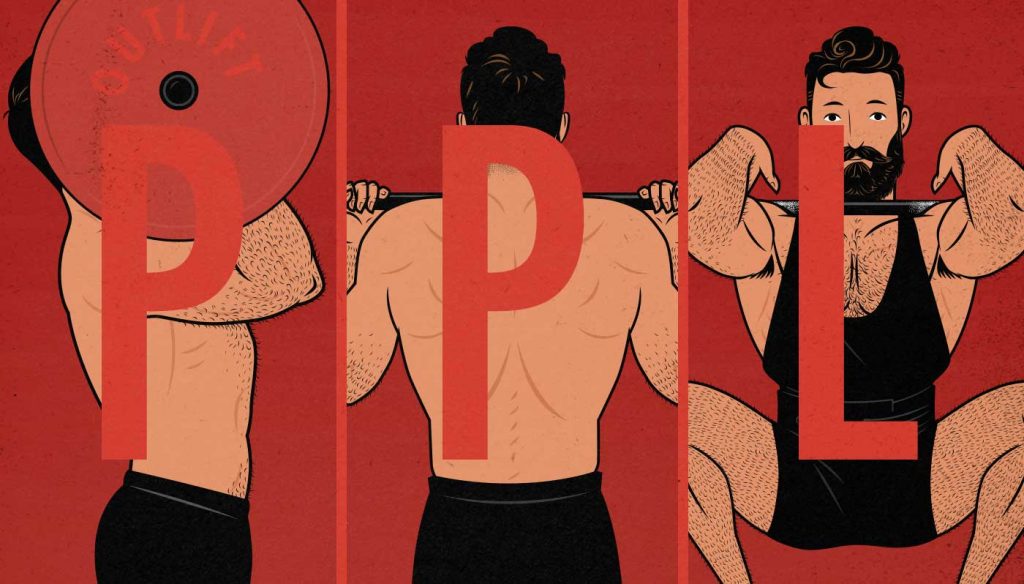
Are 3-Day Push/Pull/Legs Workout Splits Good for Building Muscle?
Push/Pull/Legs Workout Splits have been a popular way of building muscle for several decades. The 6-day version is beloved by many serious bodybuilders, while the 3-day version is more popular with casual lifters. That’s the version I want to talk about here.
The idea is to hammer a muscle with a variety of exercises, stimulate a maximal amount of muscle growth, and then give the muscle a full week to recover before training it again. Is that the best way to build muscle?
In the past few years, a substantial amount of research has come out comparing push/pull/legs routines against full-body routines. We also have a number of studies looking into how many sets we should do and how often we should train. The findings were surprising.
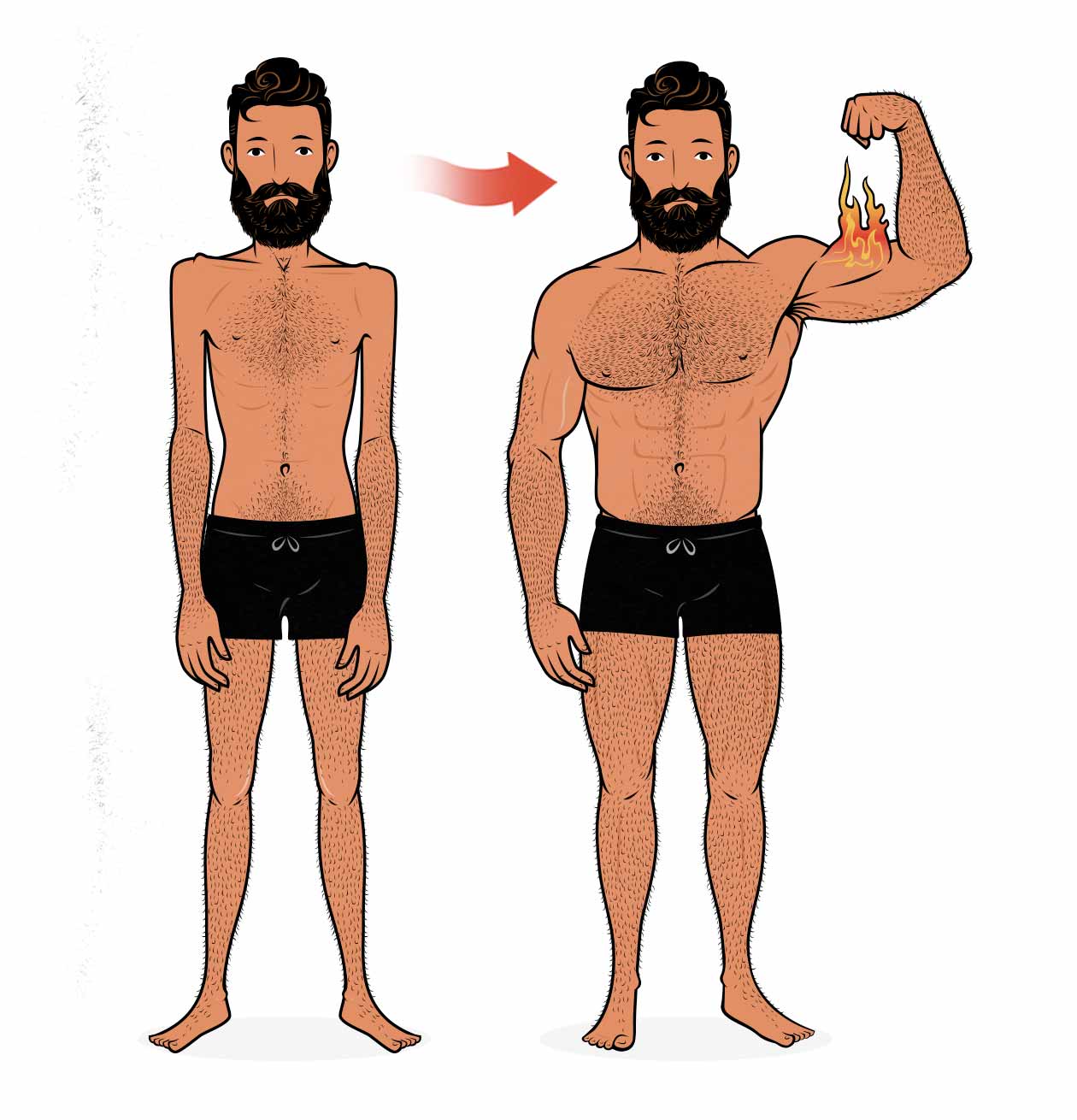
What is a Push/Pull/Legs Routine?
The Push/Pull/Legs Workout Split is a 3-day workout routine that’s divided into a push workout, a pull workout, and a leg workout, like so:
- Monday: Push Day
- Tuesday: Rest
- Wednesday: Pull Day
- Thursday: Rest
- Friday: Leg Day
- Saturday: Rest
- Sunday: Rest
Push Day is designed to stimulate growth in your chest, shoulders, and triceps. These are the muscles worked by the big pushing exercises, such as the bench press and overhead press, but there are usually some isolation lifts for the chest, side delts, and triceps as well.
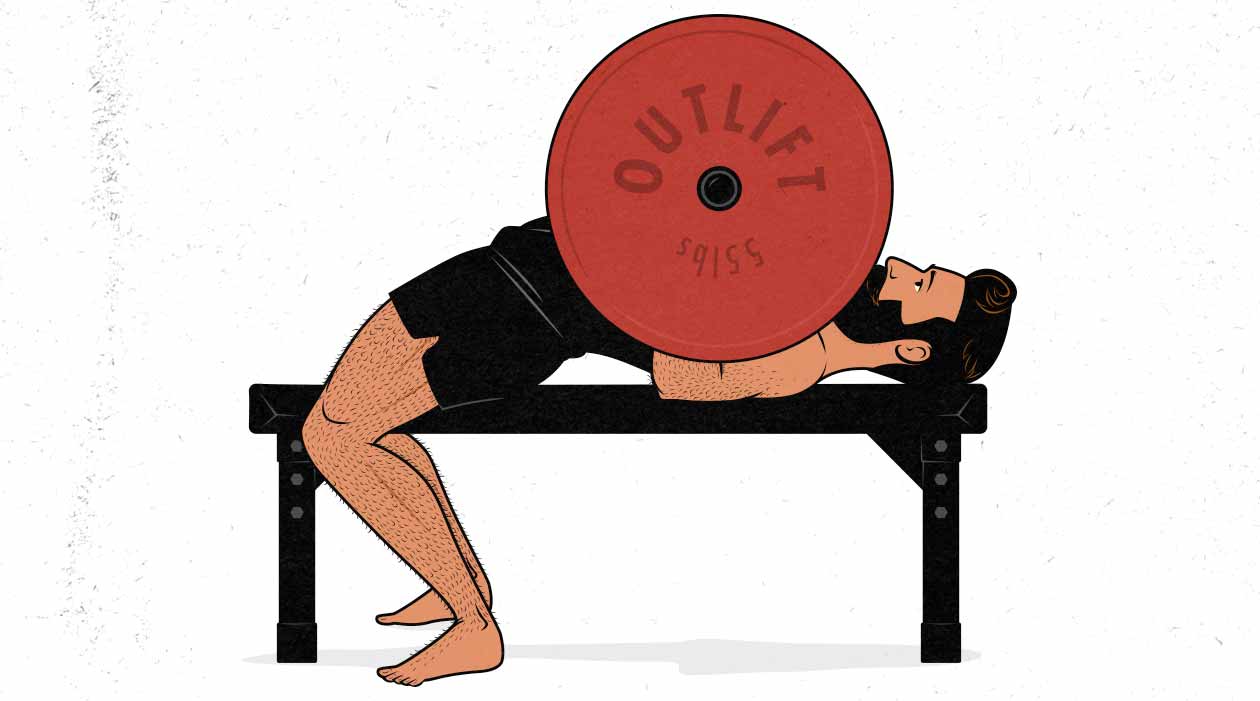
Pull Day is designed to stimulate growth in your upper back, lats, spinal erectors, biceps, and forearms. These are the muscles worked by the big pulling exercises, such as chin-ups and rows, but there’s usually some extra work for your biceps, brachialis, and forearms. Deadlifts are sometimes included as well.

Leg Day is designed to stimulate growth in your hips, quads, hamstrings, and calves. It’s built around the squat and often the deadlift. Once the big compound lifts are done, there’s usually some isolation work for the quads, hamstrings, calves, and sometimes abs. Women often add some extra glute work.
You can add extra days to the routine, too, turning it into a Bro Split. For example, you could add an Arm Day on Saturday. But in this article, we’re talking about the 3-day version.
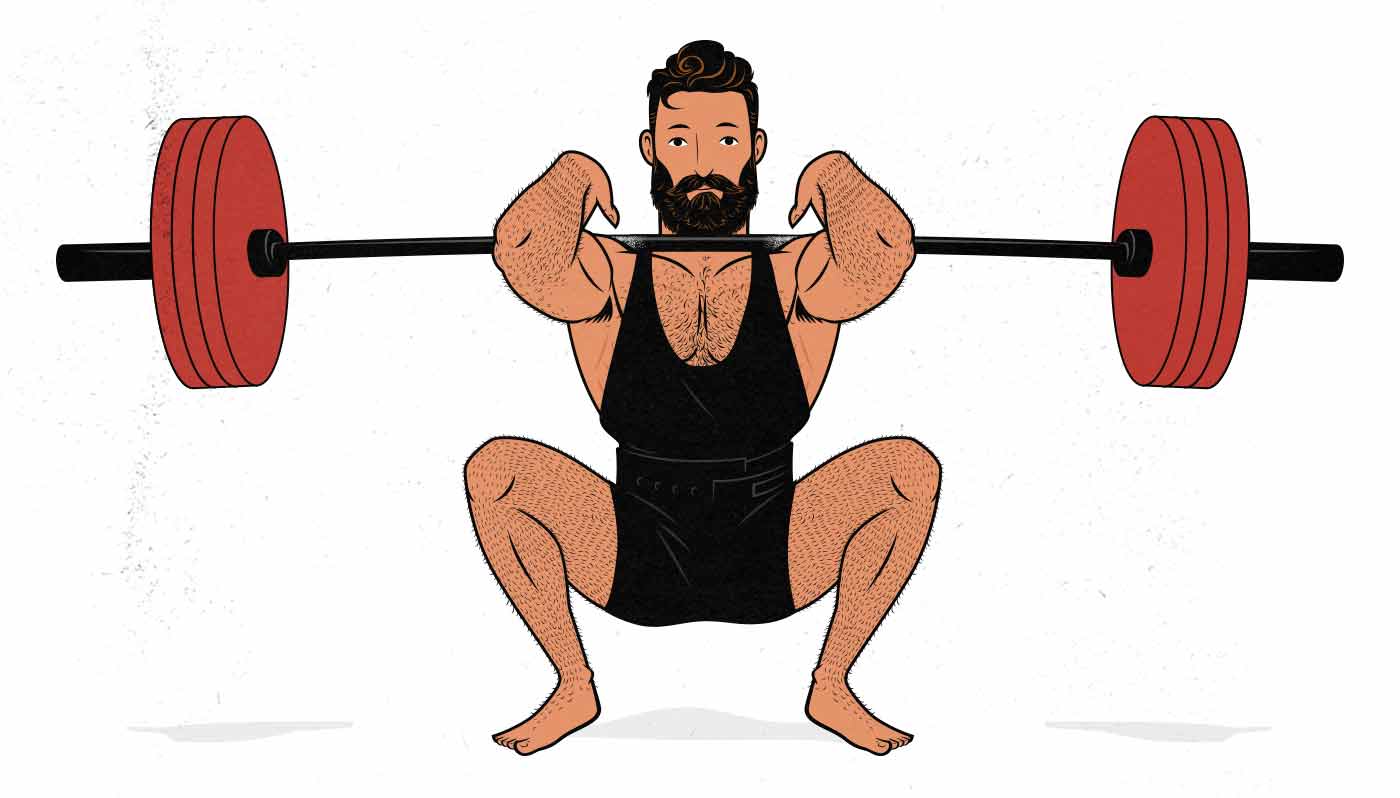
Sample Push/Pull/Legs Workout Routine
There are different ways of designing a Push/Pull/Legs Workout Split, but for the best results, we want to make sure every muscle is the limiting factor on at least one lift. That allows us to work every muscle hard enough to stimulate a maximal amount of growth.
For example, the bench press works your chest much harder than your triceps, so if you rely on the bench press to bulk up your triceps, they’d only grow half as quickly as your pecs (study). That’s why we add in triceps extensions, balancing growth between the two muscles:
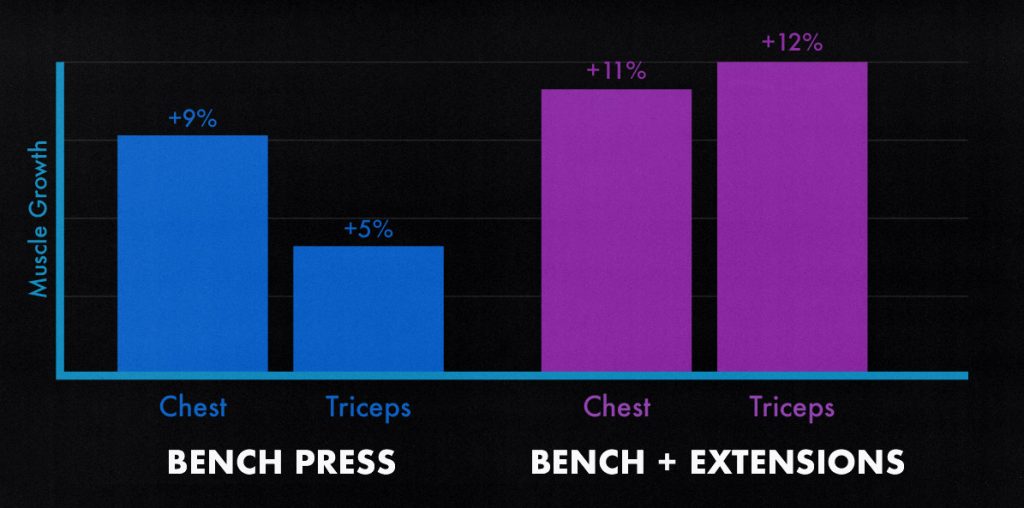
So on a push day, the bench press works your chest, shoulders, and triceps, but your chest gets hit the hardest. That’s your chest lift. So we also include an overhead press, which hits your shoulders hardest. That’s the shoulder lift. And then, we include triceps extensions so that your triceps are the limiting factor. That’s the triceps lift. And then we might want to include a lift that works our side delts the hardest, such as the lateral raise.
There’s plenty of overlap. We have three different exercises working our triceps, and two different exercises working our front delts. And that’s good. That gives us more overall training volume. The trick is to make sure that we give each muscle a chance to get close to failure.
Here’s how to do that for each day.
The Push Day Workout
To build a great Push Day workout, start with the biggest exercise. See which muscles aren’t being properly trained, and work your way down to the next biggest exercise.
- Chest: 3 sets of 8 repetitions (3×8) on the barbell bench press, chest dip, dumbbell bench press, or push-up. The barbell bench press works your triceps harder. The dumbbell bench press is better if you have stubborn pecs.
- Shoulders: 3 sets of 8 repetitions (3×8) on the barbell overhead press, dumbbell overhead press, incline bench press, or landmine press. All of these are great options.
- Triceps: 3 sets of 12 repetitions (3×12) of skull crushers, overhead triceps extensions, or triceps pushdowns. All of these are great, but the overhead extension allows you to train your triceps under a deeper stretch, making it slightly better for building muscle.
- Side delts: 3 sets of 12 repetitions (3×12) of lateral raises or upright rows. Lateral raises make a great default exercise. They’re great for our side delts.
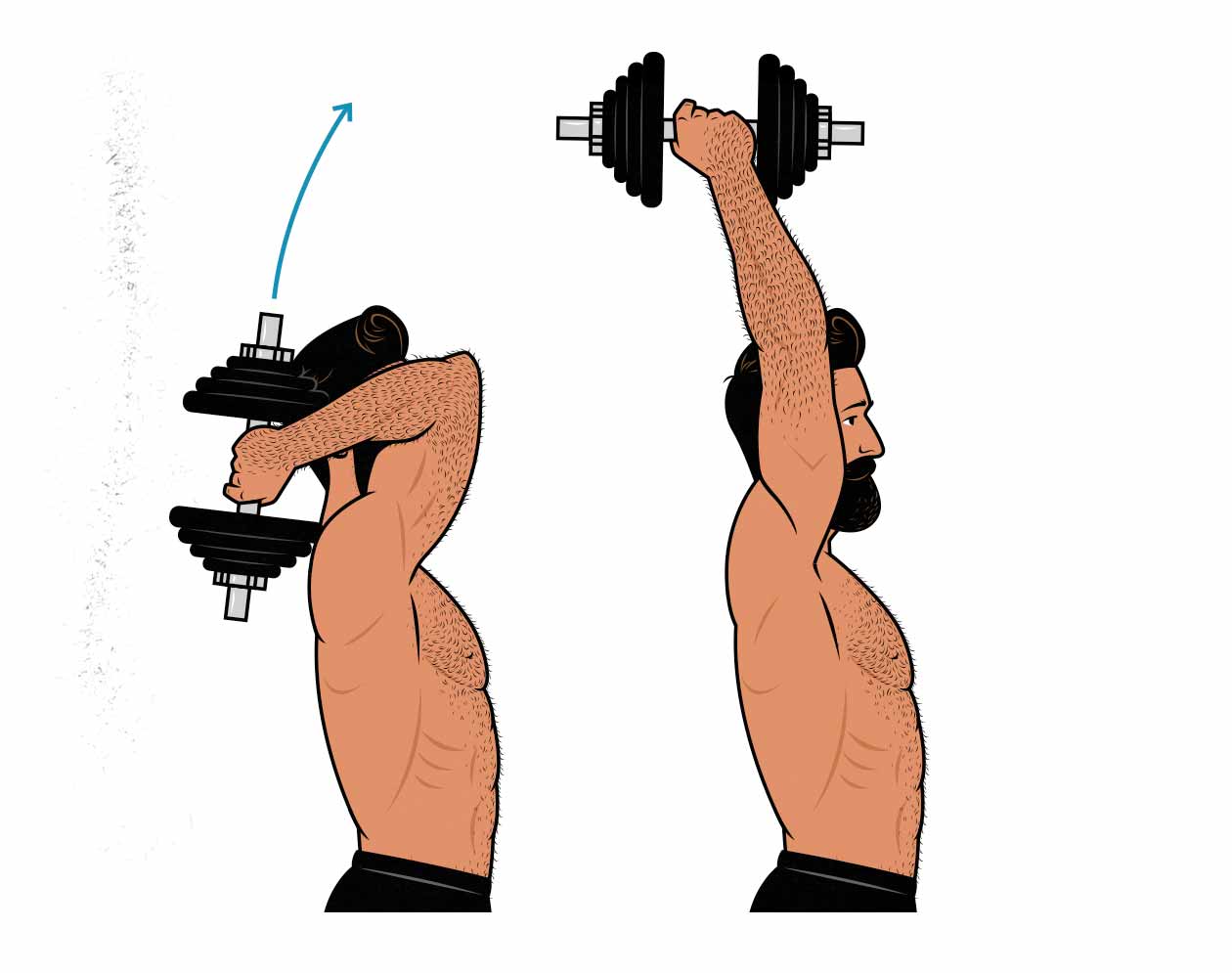
That’s a complete Push Day workout for most people, but if you find that the bench press isn’t properly stimulating your chest, you may want to include some sort of chest fly as well. The chest fly machine is great for this, as are dumbbells and cables.
There’s quite a bit of overlap between these exercises, and most of our muscles are being worked by at least a couple of them. Perhaps more importantly, each of our muscles gets a chance to be our limiting factor on at least one lift.
The Pull Day Workout
To build a Pull Day workout, take the same approach as with Push Day, starting with the biggest exercise and working our way down to the smallest one. That way, you bring your best energy to the lifts that stimulate the most overall muscle growth.
- Spinal Erectors & Traps: 3 sets of 6 repetitions (3×6) on the conventional deadlift. If you have the energy for it, the conventional deadlift will stimulate the most overall muscle growth. Otherwise, the Romanian deadlift is a great choice. It works similar muscles but is a bit easier on your lower back and traps.
- Lats: 3 sets of 8 repetitions (3×8) of chin-ups, pull-ups, lat pulldowns, or barbell rows. Chin-ups work our lats under a deep stretch and with a heavy load, making them a great default.
- Biceps: 3 sets of 12 repetitions (3×12) of barbell curls, dumbbell curls, preacher curls, or incline curls. All of these are great. The barbell curl will stimulate the most overall growth (working your upper back and forearms), but the incline curl will do the best job of emphasizing your biceps.
- Rear delts: 3 sets of 12 repetitions (3×12) of the reverse fly or face-pull. Either choice is great, so go with your preference.
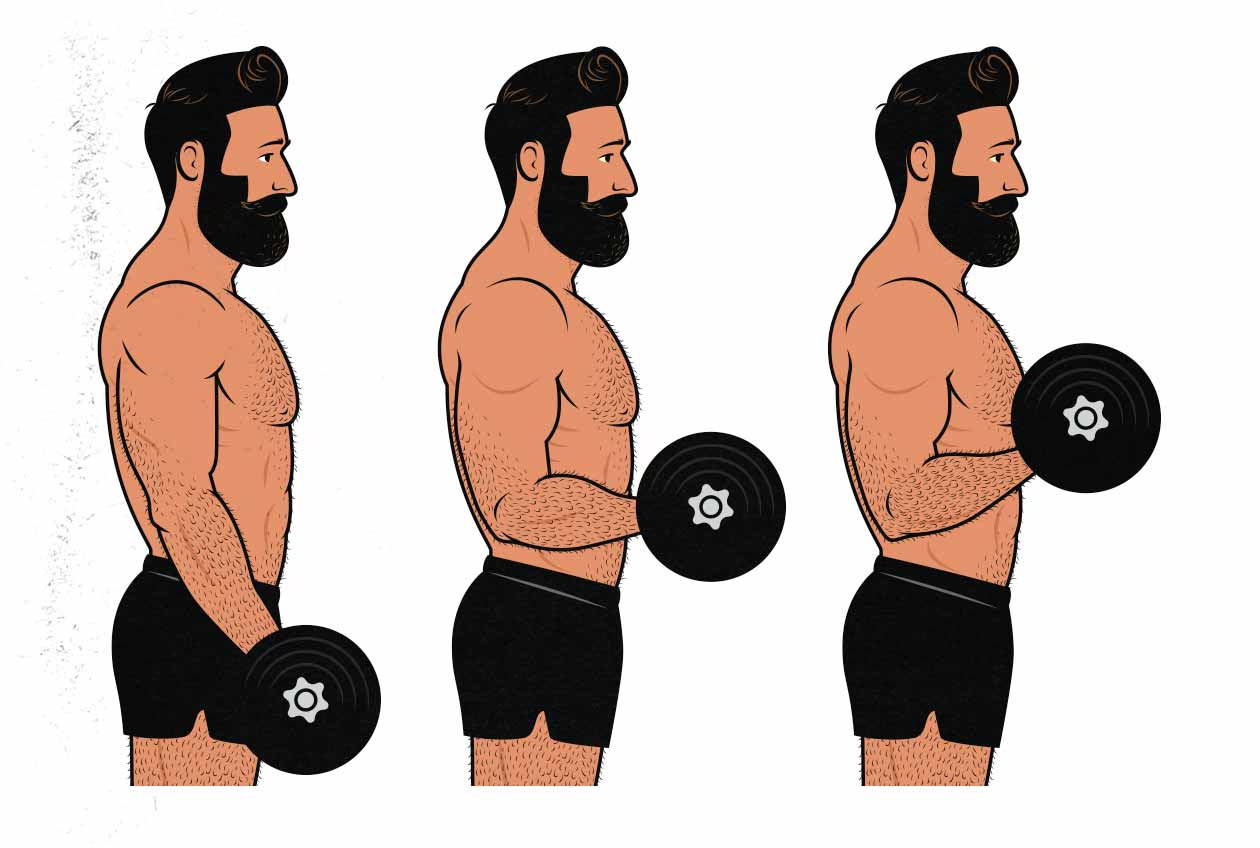
That’s a complete Pull Day workout for most people, but if you have some extra energy left over, you could also include neck extensions or wrist curls here. Neck extensions will bulk up the back of your neck, which is often forgotten. Barbell curls work your wrist flexors already, but if you want bigger forearms, adding in wrist curls can help.
The Leg Day Workout
The build a Leg Day workout, again, we want to start with the big compound lifts and then work our way down, making sure that we’re giving each muscle a chance to be the limiting factor.
Leg Days can be pretty brutal if you’re trying to do both squats and deadlifts, which is one advantage of using the deadlift as a back exercise. So in this workout, we’re using the squat as our main lift instead.
- Quads, glutes, and spinal erectors: 3 sets of 6 repetitions (3×6) on the front squat or high-bar squat. The front squat makes the best default if you want to emphasize upper back growth, but both are similarly good for your quads.
- Quads: 3 sets of 12 repetitions (3×12) on the leg extension, reverse Nordic, leg press, or Bulgarian split squat to emphasize your quads. The leg extension tends to work best because it doesn’t involve movement at the hips, which can slightly interfere with quad activation. But any quad exercise will do the trick.
- Hamstrings: 3 sets of 12 repetitions (3×12) of Romanian deadlifts, good mornings, hamstring curls, nordic hamstring curls, or glute/ham raises. The Romanian deadlift is great here, but if you’ve already done it on your pull day, some sort of hamstring curl is a good idea.
- Calves: 3 sets of 12 repetitions (3×12) of standing calf raises.
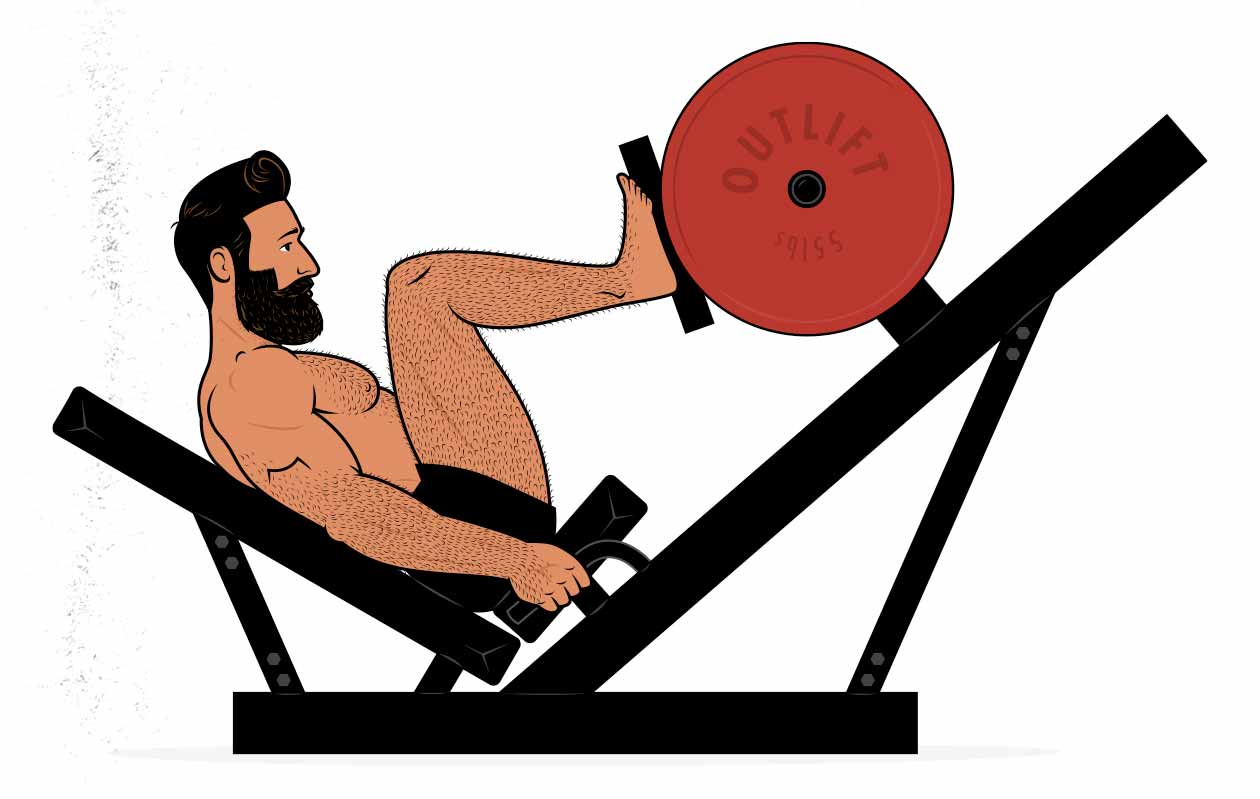
Those four lifts make for a challenging Leg Day workout for most people, but if you yearn for more, you can add in some neck curls or ab exercises. Hanging leg raises, reverse crunches, crunches, and planks are all great options for your abs.
Another thing to consider is your glutes. For most people, deadlifts, front squats, and Romanian deadlifts are more than enough for their glutes. But that’s not always the case, and so if your glutes are lagging behind, you might want to include some sort of hip thrust.
The Full Workout Routine
Now that we’re talked about how to build a push day, pull day, and leg day, we can combine them together into a full push/pull/legs routine:
- Monday (Push Day): 3×8 on the barbell bench press and dumbbell overhead press, and then 3×12 dumbbell fly, triceps extensions, and lateral raises.
- Tuesday: Rest.
- Wednesday (Pull Day): 3×6 on the conventional deadlift (or Romanian deadlift), 3×8 on the chin-up (or barbell row), and then 3×12 biceps curl, hammer curl, and reverse fly.
- Thursday: Rest.
- Friday (Leg Day): 3×6 on the front squat, 3×12 leg curl, leg extension, and calf raise. Maybe toss in some hanging leg raises for your abs and some neck curls to build a thicker neck.
- Saturday: Rest.
- Sunday: Rest.
You’ll notice that there’s overlap here, and that’s a good thing. Training our muscles twice per week tends to be slightly better than training them just once per week, so any overlap should, if anything, help you build more muscle.
Are Push/Pull/Leg Splits Good for Building Muscle?
A Summary of the Research
Push/Pull/Legs workout splits have been popular in recreational bodybuilding communities for several decades now. In fact, a survey found that a whopping 67% of bodybuilders only train each muscle group once per week. But it wasn’t just the bros and amateur bodybuilders using them. They were even recommended by leading hypertrophy researchers, such as Brad Schoenfeld, Ph.D.
To quote Schoenfeld, “The theory behind such routines is that growth is maximized by blasting a muscle with multiple exercises from multiple angles and then allowing long periods of recovery.” However, Schoenfeld notes that this wasn’t always the case. “Old-school bodybuilders such as Steve Reeves and Reg Park swore by total-body routines, working all the major muscles each and every session over three non-consecutive days-per-week. Proponents thought that the greater training frequency was beneficial to packing on lean mass.”
It wasn’t until recently that we had high-quality research comparing the two approaches. When Brad Schoenfeld conducted a study comparing a 3-day push/pull/legs split against a 3-day full-body workout routine, he found the full-body workouts produced more muscle growth (study).
In every metric that reached statistical significance (such as biceps growth), the full-body workouts did better. In fact, even in the metrics that didn’t reach statistical significance, such as strength gains and overall muscle growth, the full-body group still did better.
All of the muscles we investigated showed greater growth from a higher training frequency.
Brad Schoenfeld, PhD
This provoked a wave of new research into training frequency, with all of the studies coming to the same conclusion. If we train each muscle group with fewer sets per workout, but we do more workouts for each muscle group each week, then we can build muscle quite a bit faster (meta-analysis).
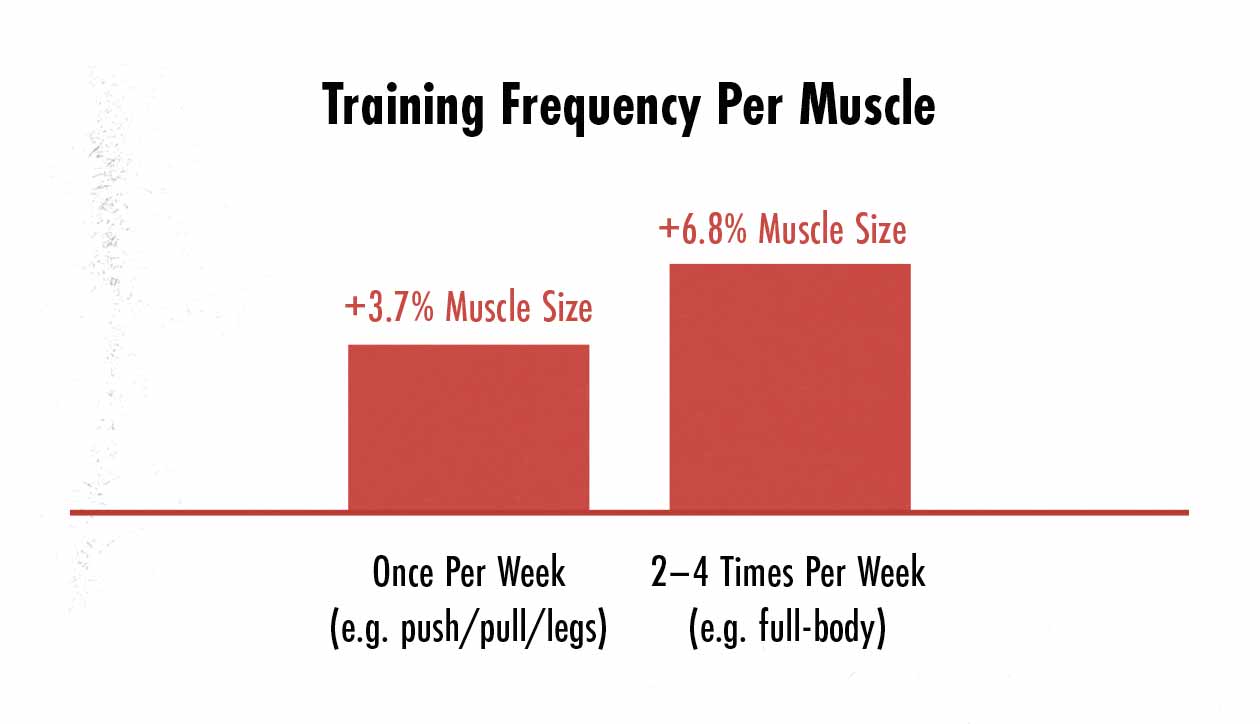
What we’re seeing is that training a muscle once per week caused a 3.7% increase in muscle size, whereas training our muscles 2–4 times per week caused a 6.8% increase in muscle size. What’s remarkable, though, is that every single study found more muscle growth with a higher training frequency.
However, there’s a fairly large caveat with these studies. Training with a higher frequency generally allows for a higher training volume. First, more overall sets can be done without running into the law of diminishing returns (which we’ll cover in a second). Second, when training a muscle with several exercises in a single workout, that muscle gets fatigued from set to set, reducing how much weight we can lift and how many reps we can do, thus reducing the training volume.
Why Does Training a Muscle More Often Yield More Growth?
A higher training frequency tends to stimulate more muscle growth because each workout only stimulates 2–3 days of muscle growth. That means that if we train our muscles just once per week, our muscles only grow for 2–3 days of the week, whereas if we train our muscles 2–4 times per week, each muscle spends the entire week growing bigger.
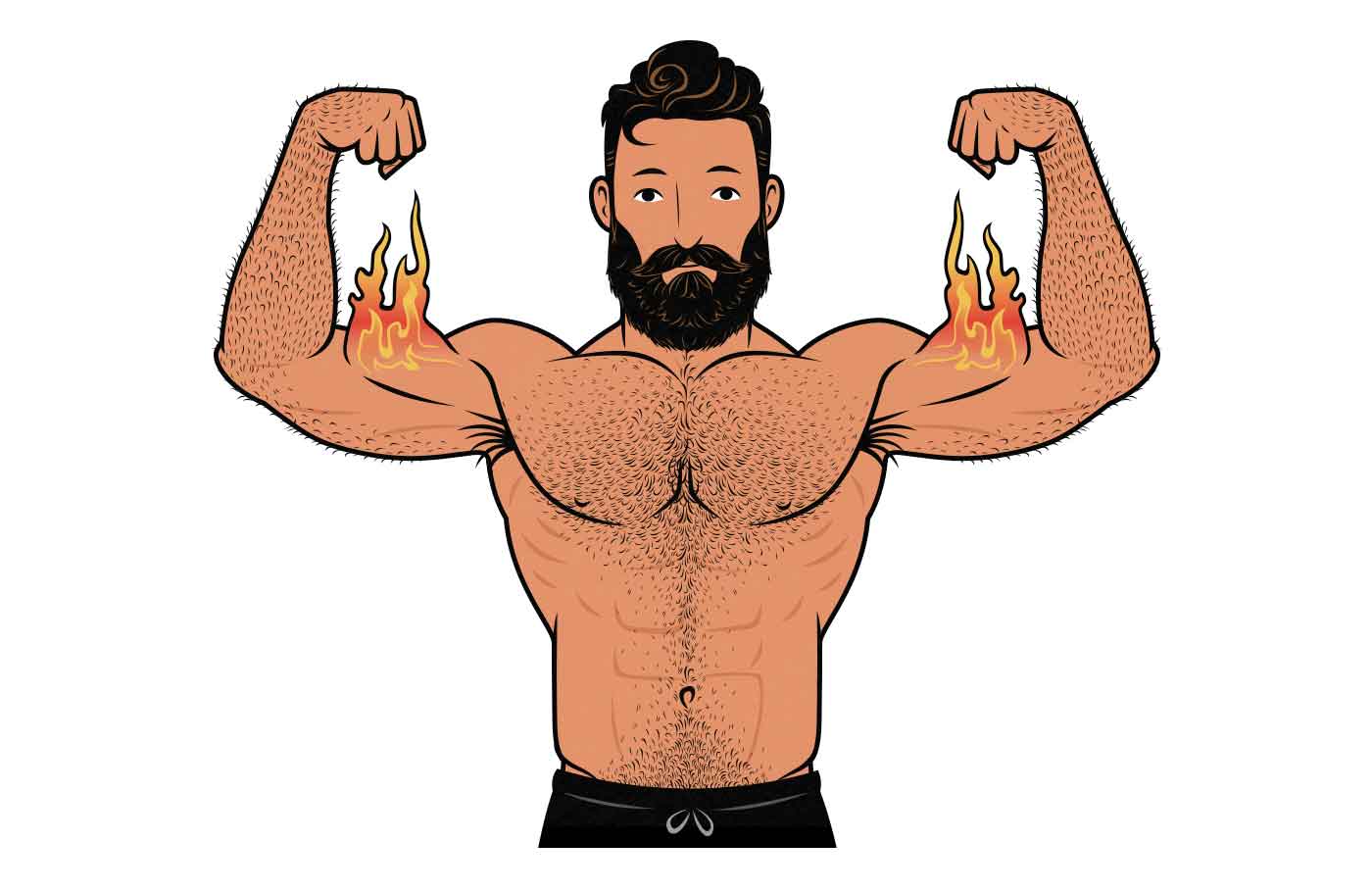
Furthermore, there’s only so much muscle growth we can stimulate in a single workout, with the law of diminishing returns rearing its ugly head quite soon. By the time you’ve done five sets for a muscle group, you’ve stimulated almost all of the muscle growth you can stimulate. You can eke out a bit more growth by going up to eight sets, but those extra sets won’t yield much extra growth. Plus, doing too many sets for a muscle group in a single workout can cause an excessive amount of muscle damage, increasing our recovery demands and reducing muscle growth (study).
As a result, if we train our muscles just once per week, we can only benefit from doing around eight sets per muscle per week. That’s a fairly low training volume. It’s not enough to maximize muscle growth. However, if we train our muscles three times per week, we can do eight sets each workout, accumulating a total of 24 sets per week, which is more than enough to maximize muscle growth. In fact, most of us can maximize muscle growth with 12–18 sets per muscle per week, meaning we can stimulate maximal growth by training our muscles with 4–6 sets per workout and training them three times per week.
(Note that being able to stimulate maximal muscle growth with just 4–6 sets per workout and 12–18 sets per week hinges on choosing good lifts, lifting within a good rep range for muscle growth, taking your sets within 1–3 rep of failure, and getting proper rest between sets.)
Instead of blasting a muscle with high training volumes once per week, as is done in push/pull/legs workouts, it’s better to stimulate our muscles with a lower volume more frequently, as is done in full-body workout routines (although there are certainly other splits that work equally well).
What’s the Best Workout Schedule for Muscle Growth?
There’s no single best workout routine for building muscle, and there are many different ways to schedule our workouts. Still, some schedules are better than others, and push/pull/legs routines don’t tend to be ideal. It’s usually better to train our muscles more frequently but with lower training volumes each workout.
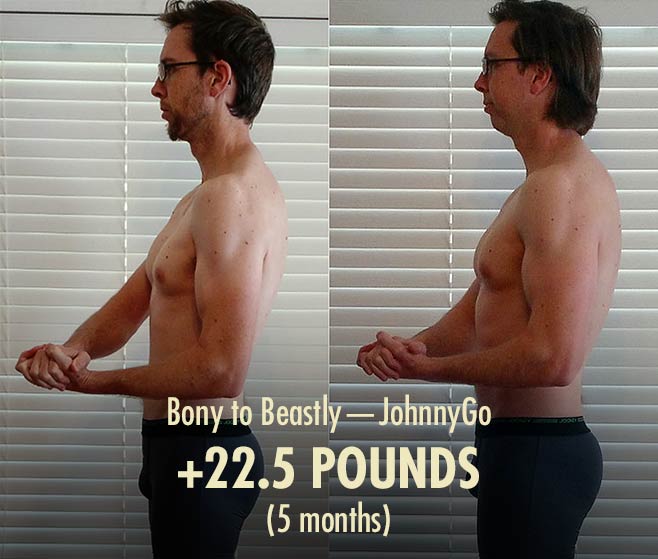
For instance, instead of doing fifteen sets for your chest on Monday, it’s better to do five sets on Monday, five on Wednesday, and five on Friday. That way, each workout stimulates a maximal amount of muscle growth, and we can keep our chests growing steadily all week long. When doing this, we can still use a wide variety of chest exercises. For instance, bench press on Monday, push-ups on Wednesday, and weighted dips on Friday. This creates a “full-body split” where there are three distinct full-body workouts each week. This way, we get the benefits of a wider exercise variety and the benefits of a higher training frequency.
Here are three good ways of scheduling your workout routine:
- 3-day full-body workout routine, which is ideal for most beginners.
- 4-day workout split routine, which is ideal for many intermediates.
- 5-day workout split routine, which allows for shorter workouts.
All of them are comparably effective, but a good default is for beginners to start with 3 full-body workouts per week. As you get bigger and stronger, you’ll be lifting more weight each rep, resting longer between sets, and the workouts will start to become long and tiring. At that point, you could start doing specialization phases where you keep training 3 days per week but focus on just a few muscle groups with each training phase. Or you could add a fourth workout day, allowing you to spread your training volume over more workouts.
If you want to train 5 or 6 days per week, that’s perfectly fine, but that’s more about personal preference than getting extra muscle growth. It becomes harder to manage fatigue, and the workouts can become less efficient, but some people prefer training more often, especially if it means shorter and more focused workouts.
Summary
3-day Push/Pull/Legs Workout Splits can be good for building muscle. They were popular because they worked. And there was even a time when they were an evidence-based recommendation. But, according to a recent meta-analysis of all the research, a 3-day full-body routine can build 48% more muscle than a 3-day push/pull/legs routine.
More remarkably, despite their popularity, there appears to be no advantage to training a muscle just once per week or with such a high volume per workout. It isn’t as good for stimulating muscle growth, gaining strength, or recovery. As a result, most modern hypertrophy routines have reverted back to the more traditional approach of using full-body workout routines.
However, that doesn’t mean that full-body splits are the only good way to build muscle. You could do an upper/lower split, a 6-day Push/Pull/Legs split, a Bro Split, or an Outlift Split. All of those routines train most muscles at least twice per week, which is enough to maximize your rate of muscle growth.
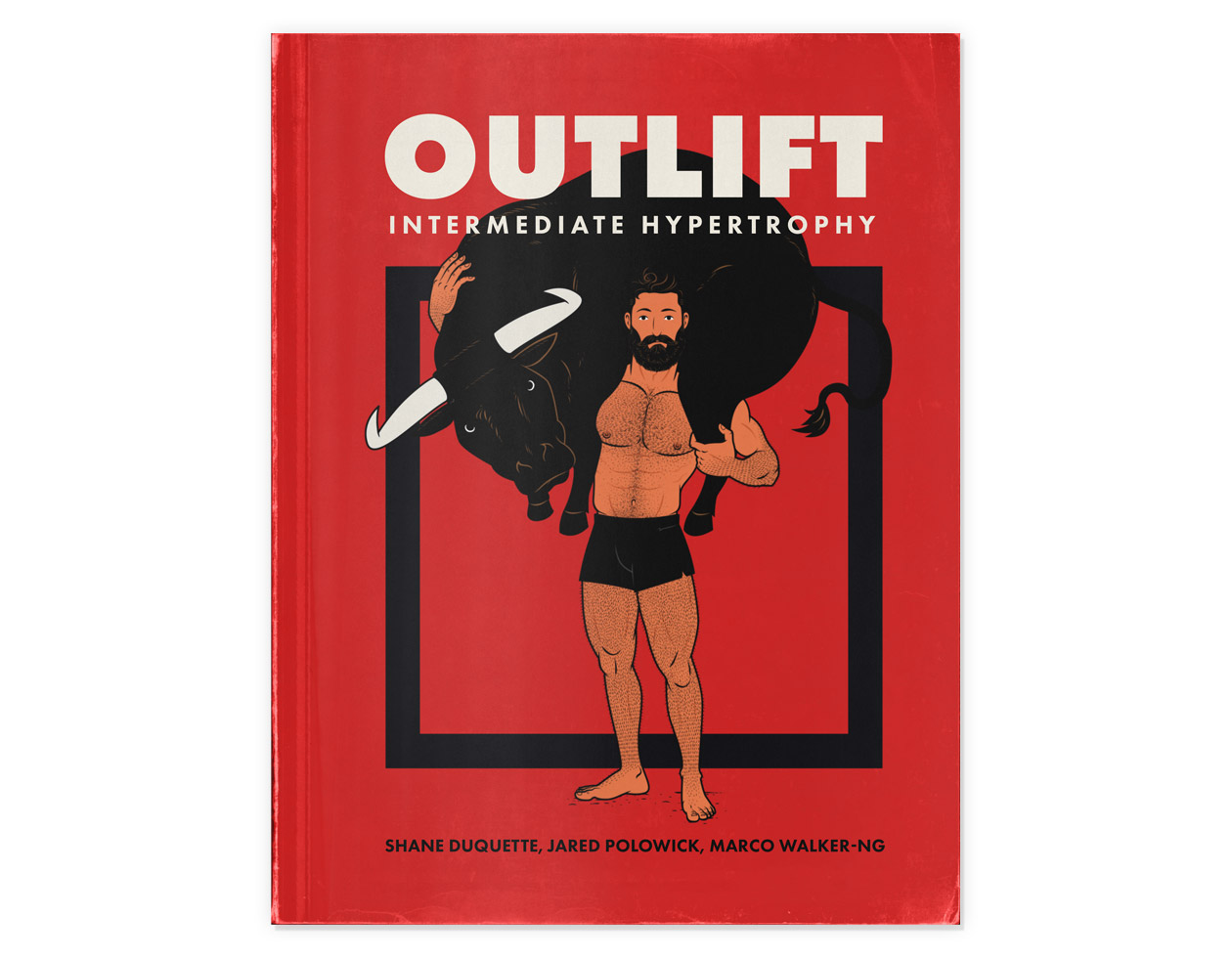
If you want a customizable workout program (and full guide) that builds these principles in, check out our Outlift Intermediate Bulking Program. Or, if you’re still thin, try our Bony to Beastly (men’s) program or Bony to Bombshell (women’s) program.



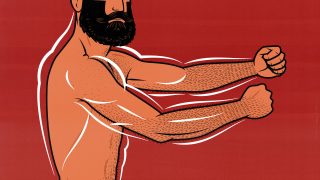
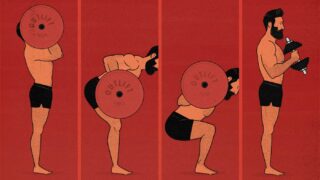
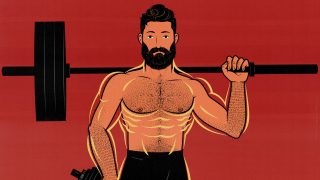
Will you ever write an article specifically on ectomorphs and Crossfit? I don’t think there has been one yet.
Hey Chase, we’ve generally avoided writing about specific brands and products, focusing instead on methods and principles. But we get a TON of questions about CrossFit, StrongLifts, Max/Size, and so on. I think a lot of us skinny guys are interested in that information. Maybe writing about those programs from the perspective of a skinny guy interested in gaining muscle size could be helpful. I would have appreciated those articles back when I was first trying to build muscle.
CrossFit incorporates a bunch of weightlifting/power training, and we do have a brand new article on that. In fact, I published the Olympic weightlifting article this morning. There’s a little section on CrossFit in there, but I can write a more in-depth article about it, too.
Hi
Nice article. Is there much research on 2 vs 3 vs more times per week. Many people who do ppl will be doing this rotation twice per week eg pplppl – rest, repeat or even on an 8 day split ppl rest ppl rest repeat. I’d be interested to hear thoughts/research outcomes on this vs 3x per week for example.
Thanks
Hey Sacha, the main downside of the classic 3-day PPL routine is that each muscle is only being trained once per week, yeah. So running a PPL routine twice per week is totally fine for people who can recover well from it. No issue there at all.
Is there an advantage to training our muscles 3x per week instead of 2x? Or 4x instead of 3x? That research is more nuanced. According to a meta-analysis done by James Krieger, MS, it appears that training each muscle group twice per week maximizes muscle growth. Beyond that, it’s all about dividing up training volume in a way that allows us to do enough sets per week while recovering properly, and there are a number of effective ways of doing that, including a 6-day PPL routine. Other experts disagree, favouring higher training frequencies of 3–5x per week, but I think Krieger’s research is quite compelling.
Because frequency and volume are tied together, we’ve written about training frequency in our training volume article, but I’ll write up a detailed article on it soon 🙂
Hey Shane great write up. I particularly enjoyed training with a 3-4 day full body split but as I grew more advanced swapped to a 5-6 day PPL. A lot of the IFBB body builders train in this kind of style and have seen a lot of success. I believe as long as you can stimulate the muscle 2-3 times with enough frequency, volume, and intensity, it should yield great results. I noticed that I am definitely more fatigued when I focus on specific muscle groups on each training day vs a full body split but you can always add more rest time. Keeping a muscle fatigued and warmer usually means the muscle is also contracting more often which is also essential when it comes to growing. At the end of the day it boils down to the type of training/programming you enjoy so that you can stay consistent.
Hey Mickey, yeah, I hear ya.
In this article, we’re talking specifically about the classic 3-day push/pull/legs splits “bro split” where each muscle is trained just once per week. Monday is chest day, Wednesday is back day, Friday is leg day. That kind of thing. They were incredibly popular in the past, but you’ll still see them in some modern bodybuilding programs. One of the most popular muscle-building programs has a 3-day PPL split in it.
Once extra days start being added in, such as an arm day, then most muscles start being worked with a higher frequency. If there’s a back day and an arm day, then biceps are being trained twice per week. That’s a reasonable training frequency for those muscles that are being hit twice per week. And a 6-day split routine where each muscle group is trained twice per week is fine, too, of course.
As for keeping muscles warmed/fatigued helping with muscle growth, I’m not sure that’s right. I asked James Krieger, MS, Menno Henselmans, and Mike Israetel, PhD, about extended rest times, and they all agreed that even resting several hours between sets wouldn’t have a negative impact on muscle growth. As a general rule, the fresher we feel, the more weight we can lift and the more reps we can get, increasing our training volume and thus increasing the growth stimulus.
And just to reiterate, even a 3-day PPL routine is okay for building muscle. It’s not ideal, no, but it will still work. A lot of people have good success training that way.
Cool article!
To be honest though, who really does PPL? That amazes me… Surely do it twice each week! I’ve done PPLPPL every week and seen huge gains! That way everything is trained x2 per week and you get 3 or 4 days rest for each muscle group every week. There’s also the 5-day full-body workouts per week option.
Would love for you to do an article comparing these 2 as they are both great options to build muscle for somebody that has past their newbie gains.
Hey Sam, yeah, I think you’re right. It seems that 3-day PPL splits have been fading in popularity ever since Schoenfeld’s study compared them against 3-day full-body routines. But there are a few popular bulking programs that still use PPL splits.
Your approach of doing a 6-day PPL split makes total sense. There are lots of good ways of dividing up training volume in a way that hits each muscle at least twice per week. That’s one of them. We’re planning to write more about training frequency, training splits, and high-frequency training (e.g. 5 full-body workouts). I figured we should start with one of the simpler but more popular splits (PPL) and compare it against another popular training style (3 full-body workouts per week), especially since there’s a high-quality study directly comparing the two.
I loved the article but was just curious on your opinion whether you believe a 6-day PPL or a Upper/Lower split is more effective and ideal
Hey Carlos, thank you!
Yeah, muscles grow best when we train them 2+ times per week, so the main downside to a 3-day PPL routine is that we’re training each muscle group just once per week. If we’re training 6 days per week, that allows us to train each muscle group at least twice without issue. At that point, it comes down to the quality of the workout program, not the split itself. It’s totally possible to have an ideal 6-day PPL routine 🙂
Shane, in your last sentence, I thought you were going to say:
“At that point it comes down to the quality of life”. As in, “Training 6 days out of 7 might hinder your quality of life because training becomes your life”. But you did not say that, so I assume you are referring to 6 short training sessions… 😉
Hah! I hear you. I prefer training just 2–4 times per week, depending on how eager I am to accomplish a certain goal. But some people really enjoy lifting every day. If that’s the case, 6-day splits can improve their quality of life, even if those workouts are long, even if they aren’t as efficient. Some people want to spend more time lifting.
Rest between sets?
Hey Cristian, we’ve got an article on how long to rest between sets here: https://outlift.com/rest-times-for-muscle-growth/
I have been doing ppl for a few months and I’m getting good results. Here’s a sample of my ppl: I do 2 workouts then 1 off day so I’m hitting each muscle twice over an 8 day period such as L then next day Push then off the third day then Pull then L off Push then Pull off repeat. This gives me a little more recuperation but still plenty of stimulation and muscle growth.
That’s sweet! Congrats on your results, man. That sounds like a great way of doing it 🙂
What are your thoughts on a 4 day split. I did ppl for a year, but switched to a 4 day.
Hey Adam, 4-day splits can be good, yeah. The trick is to design them in a way where you’re stimulating every muscle group (that you’re trying to grow at full speed) at least twice per week.
Is it okay to train:
Monday: chest, shoulders, triceps
Wednesday: legs, back, biceps
Friday: chest, shoulders, triceps
Monday: legs, back, biceps
Hey Jasmin, yeah, that’s okay.
You’re hitting every muscle group every few days. It might not be quite ideal, since the frequency is still a bit low, but it’s better than a 3-day push/pull/split.
You might be able to gain muscle slightly faster by adding a fourth day, like so:
Monday: push (squats, overhead press, chest, triceps)
Tuesday: pull (chin-ups, back, hamstrings, biceps)
Thursday: push (bench press, shoulders, quads, triceps)
Friday: pull (deadlifts, back, biceps)
But your idea is good, too 🙂
Thanks Shane
No prob!
Hi Shane,
So recently I moved from a 3 day split to a 4 day split, and coincidentally enough i’m following an almost identical routine to the one you have suggested here, using a mix of free weights, and cables/machines.
Monday – Bench press, Leg press, shoulder press machine, chest fly, lateral raise, skull crushers
Tuesday – Deadlift, Seated cable row, lat pulldown, preacher curl
Thursday – Squat, OHP, incline chest press machine, cable crossover, lateral raise, overhead tricep extension
Friday – Chinup, RDL, T-bar row, Facepull, Barbell curl
I’ve gone for a mainly upper body focus, but with enough leg volume to get some growth. Would you say that my routine is fairly balanced, or are there any ways I should tweak it? Any help would be much appreciated!
Hey Shane, I’m not sure how to do my workout split.
I work 3 days in a row at a very active job, so normally I only have 4 days to train. I’m interested in getting stronger on my upper body and some hypertrophy on my lower body. What do you think about this routine?
Friday – PUSH
Saturday – LEGS (quad & calves)
Sunday – PULL
Monday – LEGS (hams and buttocks)
Tuesday, Wednesday, Thursday – REST
*glutes! sorry
Hey Maite, that split would work.
Ideally, though, you’d train each muscle at least twice per week, so you’d probably get slightly better results with an upper/lower split. Like this:
Friday – Lower (main squat, hip hinge assistance, accessories)
Saturday – Upper (main push, pull assistance, accessories)
Sunday – Lower (main hip hinge, squat assistance, accessories)
Monday – Upper (main push, pull assistance, accessories)
Tuesday, Wednesday, Thursday – Rest
So for example, Friday might have you doing high-bar barbell squats as your main lift, then doing with your favourite hip hinge next, such as good mornings, Romanian deadlifts, glute bridges, or hip thrusts. And then pick one or two accessories for your target areas, such as leg extensions, hamstring curls, standing calf raises, and so on. You’re stimulating muscle growth in your entire lower body, but the emphasis is on your squats.
Then on Sunday, you flip the emphasis. Choose your main hip hinge first, such as a deadlift or Romanian deadlift. Then do a squat accessory, such as goblet or split squats. Then a couple of accessories for your target areas.
Same idea with the upper-body days. One day could start with rows or chin-ups, the other day could start with push-ups or the bench press.
The thing to watch out for is overworking your spinal erectors and postural muscles, since they’ll be involved in every workout. That might mean it’s better to choose accessory lifts that don’t load your spine as heavy. For instance, choosing hip thrusts instead of good mornings. Choosing one-arm dumbbells rows instead of barbell rows. That kind of thing.
We plan to publish an article on upper/lower splits soon where we can go into more detail 🙂
I hope that helps!
Oh, and to gain size in your lower body while developing strength in your upper body, you can just put more volume on the lower-body lifts.
For example, do 4 sets of 10 repetitions on your squats and deadlifts and 3–4 sets of 12–20 reps on your assistance and accessory lifts. Then for your upper-body lifts, do 3 sets of 5–10 repetitions on your main lifts, 2–3 sets of 8–15 reps on your assistance and accessory lifts. That way you’re investing a bit more of your time and energy into the lower-body training, but you’re still doing some solid strength training for your upper body 🙂
Hi! Thank you for all of your info. You rock!
Now what if we organize a PPL split into a twice per week frequency like so:
Day 1: Push
Day 2: Legs
Day 3: Rest
Day 4: Pull
Day 5: Rest
Day 6: Repeat back to Day 1
Wouldn’t that technically make the frequency about teice a week?
Hey Rob, if you’re training 5+ times per week, a PPL split can start to make more sense, yeah. That’s correct 🙂
Can I use the exact PPL sample you wrote above (same exercises, sets, and reps) if I make ppl 5 times a week? Or is the lack of exercise variety an issue if I did that?
Yeah, you could do that. The volume in this sample routine isn’t all that crazy. I think you could manage it 🙂
I plan on writing a new article on 5–6 day workout splits, too.
Cool! I was worried about not having Rows in that Sample Routine. I actually do not like Rows. But I love Deadlifts, Chinups, and Reverse Flys. So as long as I am doing Deadlifts, Chinups, and Reverse Flys, I do not need Rows at all?
Hey Rob, you don’t need rows, but they’re a great lift, and most of our workouts include some rowing. You could replace some of the deadlifts with rows if you like. But no, your wings won’t fall off without them. Chin-ups and deadlifts have you covered 🙂
Great article! After reading it, I immediately decided to change my workouts from upper/lower split to full-body and the results were incredible.
I’d been working out every other day using an upper/lower split for about 18 months with pretty good results, but the last month or two my progress started to flag. I also noticed that I was becoming overly fatigued and not recovering completely between workouts, even though I had four days before I hit the same muscles again. Each workout had five or six exercises, so I wasn’t killing myself with volume, but I couldn’t figure out what the problem was.
After switching to a full-body routine, I started making progress again right away. My recurring fatigue was reduced immediately, and I was able to add reps/weight to my exercises across the board at an increased rate. I was even able to add another movement to each workout while enjoying better recovery. I’ve even started putting on weight again (I was stuck around 192 for months but jumped to 197 in just a few weeks).
I’m a true believer now when it comes to full-body workouts. You helped me resolve a problem that was holding me back, and for that I thank you. Keep up the great work!
That’s awesome, Anthony! 😀
There’s something to be said for doing what works while it works, and then switching things around when it stops working. You may find that you run into a plateau with full-body workouts, at which point switching to something else becomes the better approach. You’ll have to play that one by ear. But I’m definitely a huge fan of full-body workouts, and I’ve built virtually all of my muscle that way.
Thank you so much!
Hello Anthony Moulesong,
You switched from “every other day using an upper/lower split” (so full-body once every 4 days) to a “full-body routine”.
How often do you do your full-body sessions?
If your new frequency is 1 full body session more or less often than every 4 days (4 days = your previous frequency), do you think the improvements you report might be due more to frequency change (from full-body every 4 days to your new frequency) and less to split change (from upper/lower to full-body)?*
Thank you,
F
*yes, I was not able to phrase the 2nd question any more awkwardly…;-)
Hello!
I do a workout every other day, so I rest one day between workouts. I do the same number of exercises as before (I actually was able to add one). The only difference is the way I arrange them. Now, I do half of my upper body and half of my lower body exercises one workout, and then the other half of each the next workout two days later. Given that the only difference is the split (not the overall volume or rest period), I assume that the difference is that I’m not overly fatiguing my upper body or lower body even though I’m doing the same amount of work.
Hello Anthony,
Thanks for elaborating on your former & current splits.
In your 1st comment you said “Each workout had five or six exercises”, regarding your previous schedule.
In your 2nd comment: “Now, I do half of my upper body and half of my lower body exercises one workout, and then the other half of each the next workout two days later”.
3 questions:
1. How did you arrange your 11 original exercises into your 2 current Full-Body routines?
2. How many sets per exercise did you use to do? Same number now?
3. Have your sessions’ Duration and/or your between-sets & between-exercises Rest changed?
Thank you! Your example is very helpful to me.
F
So after reading this, it sounds like if you’re only lifting 3 days per week, then the best option is a full body workout, with about 15 -20 sets per major muscle group per week? Does that sound about right?
Hey Mike, yeah, you could do an upper-body workout, a lower-body workout, and a full-body workout and still hit each muscle twice per week, but full-body workouts tend to be the best default.
For training volume, it really depends. The range is pretty wide, and it can change over time, can change with the muscle group. Instead of aiming for a fixed number, it’s usually better to start on the lower side and work your way up as needed. So that might be 3–4 sets per muscle per workout, giving you a training volume of more like 9–12 sets per week. And then from there, if your muscles aren’t getting fatigued, pumped, and sore, or if you’re having trouble gaining strength, then you can think about adding extra sets until you’re doing 20 sets.
For more, we’ve got a full article on how many sets to do: https://outlift.com/hypertrophy-training-volume/
Hello Shane,
You said above that Romanian Deadlift (RDL) may go either on Pull or on Leg day.
In your opinion, which is best day for the RDL when the Chin Up is main Pull move and the Squat is the main Leg move (and if the conventional deadlift isn’t in the program)?
Thank you very much,
F
The Romanian deadlift is more of a leg lift than the conventional deadlift. It would fit better on a leg day, given that the main muscles being worked are your hamstrings and glutes. And I find they go well after front squats.
Maybe have a barbell row on your pull day, then, to give your lifts a bit more overlap from day to day.
I was surprised to read the title of this article in Google, but it makes sense once you actually read and see that it’s only referring to 3-day PPL.
Whenever I read PPL, I ~always~ assume they mean 6-days a week. Most proponents of PPL are big on the frequency part (just as you are), and so a 3-day-split makes limited sense.
For example, all the PPL routines you are likely to think of are 6-day, not 3-day. For example, Reddit PPL, Coolcicada’s PPL, Spiderman997, and Metallicdpas PPL are all 6-day, and I can’t think of any more prominent PPL routines than those.
Hey Terminator,
It doesn’t surprise me that the most renowned PPL routines are 6-day routines. The one I’m most familiar with is Jeff Nippard’s, and he recommends a 6-day routine as well. With that said, the majority of recreational bodybuilders and casual lifters train 3 days per week using a 3-day PPL routine, or at least that was the case back when these studies were being done. Brad Schoenfeld, PhD, ran a survey. They’re very popular. Just perhaps not so popular in the evidence-based or niche online lifting communities.
But I don’t disagree with you, and these things are always changing. Now that it’s more well known that frequency is important, it wouldn’t surprise me to learn that 3-day PPl routines aren’t as popular anymore.
More recent research from Brad Schoenfeld (cited below) appears to indicate little difference in frequency when the training volume is equated. Maybe a 3-day per week PPL is not so bad after all?
https://pubmed.ncbi.nlm.nih.gov/30558493/
I think that’s right. I don’t think training frequency makes a big difference, especially when comparing once per week against 2–4 times per week.
I don’t think 3-day PPL routines are that bad. I don’t think they’re ideal either, though. I think the research still leans in favour of training a muscle 2–4 times per week. Once per week is fine, though, if you prefer it.